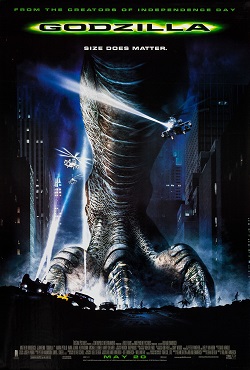
The Godzilla series from Toho Studios is one of the longest-running cinematic franchises in history. Only the James Bond series has had more consistent theatrical releases since its start (the Godzilla series boasts more live action films at 32, but there have been some rather lengthy breaks). Godzilla himself, a dinosaur mutated by nuclear radiation into a destructive fire-breathing titan, is one of the most recognizable characters in the word, as his Stegosaurus spins give him a distinctive silhouette. I was introduced to the character at the age of ten or eleven when I found a series of children’s books on movie monsters at the library. While checking out some of the movies I became hooked on Godzilla in particular and have been a fan since.
Godzilla has gone through numerous changes in his storied filmography. He started off as a serious and tragic representation of Japan’s experiences with nuclear weapons and wartime devastation, but has also been an antihero, flat-out villain, and cartoonish superhero. Brought to life by director Ishiro Honda and special effects master Ejji Tsuburaya, he helped launch the Kaiju genre. His thirty plus movies run the gamut from legitimate masterpieces to flat-out dreck. This is my attempt to rank all the live-action films (I couldn’t muster the will to rewatch the anime trilogy, which has some interesting ideas but is given over to dull pacing and overlong philosophical waxing).
I sometimes use the term Kaiju. Kaiju refers to the genre of giant monster movies. Many say the terms only applies to Japanese or Asian monster movies. I should also list the eras of Godzilla films with dates so you can understand some of the other references I make.
Showa Era (1954-1975) The Showa Era began with the first Godzilla film and spawned numerous Kaiju and sci-fi films. Its financial and creative peak was the early to mid-sixties. Going into the 70s the Japanese film industry went into a depression as TV took over. The Godzilla series fell into campy fare, just starting to get better before the franchise was put to rest.
Heisei Era (1984-1995): The Heisei Era started with Godzilla’s return in 1984. It took some time for sequels to develop and then fans got one new movie a year. The Heisei series was noted for its attempt at a solid continuity instead of the loose universe of the Showa Era. The movies took on a more serious tone even with the later introduction of fantastical elements like time travel.
Millennium Era (1999-2004): Also known as the Shinsei Era, this period began in response to Tri-Star’s blasphemous take on Godzilla. It went the opposite direction of the Heisei Era by allowing each director to retool the continuity for his own purposes. This resulted in some good new takes, but also confused moviegoers. The series was not as financially profitable as the Heisei series and was given a big finale with Godzilla: Final Wars.
Reiwa Era (2016-present): This era began with best picture winner Shin Godzilla. Despite the movie’s box office and critical success, Toho has yet to make any more live-action features, focusing on anime instead.
American: Tri-Star Pictures created the much maligned Godzilla in 1998. Legendary Pictures is currently taking a much more well-received (if still critically mixed) crack at the Big G.
With so many movies to choose from this was a very difficult task. My opinions will probably change in the future, especially in the middle rankings. Since there are 33 films, I will release the ranking in three parts of 11 films each. Our first entry is actually not in the rankings.
Off the List
Godzilla (1998)

Plot: French nuclear weapons testing in the Pacific mutates an iguana into a massive dinosaur-like beast. For some reason it chooses to cross Central America and go all the way to New York City, where it immediately causes chaos. While the US military inadvertently causes more damage in while trying to destroy the creature, a scientist who specializes in radiation and mutation discovers that it’s pregnant!
Mini-Review: Tri-Star Pictures gained the rights to make an American Godzilla movie in the 90s. Fans were excited to see a Hollywood-budgeted Godzilla film with CGI (still very new at the time), and early concepts for the film looked pretty good. Then Roland Emmerich and his producer Dean Devlin, fresh off their smash success with Independence Day, got the gig. The problem is that they did not respect or understand the character. They tried to create a more realistic animal and turned Godzilla from a nigh-indestructible god of natural destruction into a T-Rex rip-off who runs away from the military, doesn’t breathe fire, and gets killed by mere missiles. Fans were pissed, while many non-fans and critics blasted the movie for simply being dumb.
I took this film off the list because technically it’s better than several other Godzilla films, but it’s still the biggest bastardization of the character and concept. Taken as a non-Godzilla film (the spines and roar are still there), it’s actually an enjoyable dumb 90s action flick. The special effects team can’t seem to decide what Zilla’s size is, some of the main characters are weak and unlikeable, and Emmerich fails to really give the asshole characters proper comeuppances (he turned his nemeses Roger Ebert and Gene Siskel, famed movie critics, into an incompetent mayor and his yes man; The real-life critics dunked on him for not actually having their characters suffer a comically horrific death). The legitimate positives are Jean Reno as a French foreign agent and David Arnold’s awesome musical score.
Saturday Morning Junk
#32: All Monsters Attack (1969)

Plot: A young lower-class and somewhat neglected boy, Ichiro, fantasizes about trips to Monster Island to escape his real life where he’s constantly tormented by bullies. In the dream world he befriends Godzilla’s son Minya. Together they watch Godzilla pummel other monsters via stock footage from previous films. Minya has his own bully, a red-haired abomination named Gabara. Continue reading →





